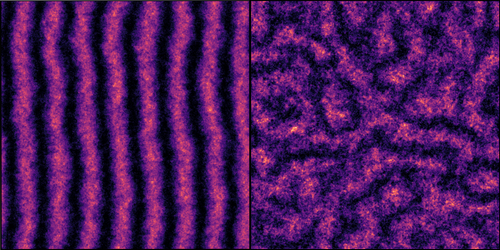Quantum Emulsion Predicted in BEC
Nineteen years ago, theorists proposed that electrons within a metal-oxide-semiconductor field-effect transistor (MOSFET) could spontaneously segregate by spin into a pattern of small, irregular patches. They dubbed the phase a microemulsion. Now Ethan McGarrigle of the University of California, Santa Barbara, and his colleagues propose that an analogous microemulsion of magnetized patches can form in a two-dimensional Bose-Einstein condensate (BEC) [1]. Given that researchers can more easily vary the parameters that control the behavior of atoms in a BEC than they can for electrons in a MOSFET, the finding could enable exploration of both the microemulsion and its neighboring phases.
The key ingredient in making a MOSFET microemulsion is the presence of long-range Coulombic interactions. By contrast, McGarrigle and his colleagues show that a BEC microemulsion state requires a coupling between an atom’s spin and its momentum. The researchers consider the case of a type of coupling in which all of the ground-state atoms possess momenta of the same magnitude, but their momentum directions vary randomly in the xy-plane. At absolute zero, quantum fluctuations break that rotational symmetry and drive the formation of a phase in which the atoms arrange themselves into a spin-striped pattern. The stripe width depends on the magnitude of the ground-state momentum.
To calculate what happens at higher temperatures, the researchers use a simulation approach based on quantum field theory. They find that the characteristic width of the striped BEC survives. But as the temperature rises, thermal fluctuations break the spin stripes into irregular patches that resemble those seen in microemulsions of two immiscible components. McGarrigle says he’s hopeful that the spin microemulsion and its neighboring phases will soon be observed. A team from the Joint Quantum Institute at the University of Maryland came close two years ago, but the setup lacked the requisite directional degeneracy.
–Charles Day
Charles Day is a Senior Editor for Physics Magazine.
References
- E. C. McGarrigle et al., “Emergence of a spin microemulsion in spin-orbit coupled Bose-Einstein condensates,” Phys. Rev. Lett. 131, 173403 (2023).




